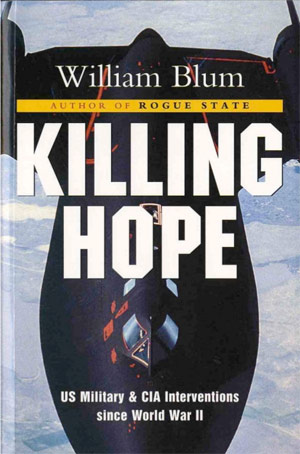
William Blum’s Killing Hope serves as a formidable compendium of US foreign invasions and interference since 1945, finds Ralph Graham-Leigh

William Blum, Killing Hope. US Military and CIA Interventions since World War II (Zed Books 2014), 471pp
Killing Hope is a lengthy and detailed account of US military and CIA interventions in other countries since 1945. It was originally published in the UK in 1986 as CIA: The Forgotten History, and was first published in the US in 1995, with an updated introduction. This 2014 edition has a brief new chapter on ‘The American Empire: Post Cold War’ and includes some updated notes and an addendum.
Blum is an investigative journalist and has amassed a huge volume of evidence of US foreign interventions, particularly those which were clandestine at the time and which contravened stated US policy. The primary focus of the book is on presenting the mass of evidence Blum has collated. Blum presents a very powerful weight of evidence, but the focus on presenting facts means the book sometimes reads like a reference work and lacks a strong sense of narrative or analysis.
Blum outlines his argument in the brief introduction. He argues that US interventions resulted from a consistent theme in US foreign policy; that from the Russian Revolution onwards, US policy was driven by an overriding anti-communism. This stemmed from US capitalists’ fear of Bolshevism and socialism. From as early as 1918, US mass media consistently portrayed communism as evil, irrational, fanatical and anti-American, resulting in an enduring and constantly reinforced view in US public opinion that communism was an evil opposing force.
By 1945, this anti-communism had been in place for 25 years, with a brief break from 1942-45. US policy makers were themselves shaped by this ingrained anti-communism, and also used it to justify their attempt to prevent the successful implementation of the policies of any socialist regime. They could also justify any of their foreign policy actions by explaining those actions as anti-communist, regardless of whether the targets of the action were actually communist in any way. Blum also briefly argues that US mainstream opinion is in denial about the impact of US interventions since 1945 – a few million deaths and misery for many millions more. He speculates on the causes for this denial, comparing this to other groups denying mass atrocities, such as Germans within Nazi Germany, and Western communist sympathisers’ denials of Stalin’s purges.
Later in the book, Blum expands this argument, stating that US foreign policy was shaped by the needs of the US military-industrial complex. For example, he strongly argues that the apparent tacit US encouragement of Iraqi occupation of Kuwait in 1990 followed by a huge disproportionate US military response was primarily motivated by the needs of the US military-industrial complex to avoid cuts after the end of the Cold War.
The main body of the book is a detailed compendium of US foreign interventions since 1945. These are split into 54 chapters, based on countries or regions and loosely presented in chronological order, beginning with US intervention against China from 1945 to 1960s and ending with Haiti 1986-1994. These chapters are well-referenced and appear to be meticulously researched. He uses open sources such as senate hearings and press reports to build up a significant weight of evidence of US interference in the internal affairs of dozens of countries. The volume and weight of facts builds up a detailed picture of US hypocrisy and deceit, which manifests itself primarily in two ways.
Firstly, the US government consistently claimed to be supporting ‘democracy’ but in fact overthrew and undermined democratically elected governments, and interfered with the democratic process of dozens of foreign countries. The US engineered military coups, installed and supported dictatorships and attempted to assassinate foreign political leaders; Blum includes an appendix of US assassination attempts. Secondly, the US government changed its portrayal of whether a foreign regime or party was to be viewed as ‘communist’, based on whether the regime was seen as acting in the US government interest. The overall result is a powerful compendium of facts of US intervention in the internal affairs of dozens of countries in Africa, Asia, Europe and the Americas.
The book functions well as a reference work, and although Blum’s sarcastic style is often engaging, it can be a difficult read. Due to the small typeface the book is lengthier than its 471 pages would initially suggest. Blum assumes that readers are familiar with the basic internal events of the countries he discusses, so it can be difficult to follow if the reader is not familiar with, for example, Guatemalan regime changes in the 1950s. The chapter structure is partly chronological and partly geographic, and as chapters vary significantly in length – for example under two pages for Iraq 1972-75 or eighteen pages on El Salvador 1980-84 – this can result in sudden shifts between geographies and periods, obscuring underlying themes. The slightly disjointed feel is exacerbated in some other ways. Some chapters have not been updated since the 1995 edition – the Zaire chapter refers to Mobutu still being in power and refers to Zaire as the country’s current name. Some well-known US foreign interventions, such as Beirut in the early 1980s, Iran from 1979 onwards, Somalia and former Yugoslavia in the 1990s and Israel/Palestine, are omitted or referred to only briefly. These omissions are not explained, but are presumably due to the book’s original 1986 edition covering CIA interventions only.
This is a very useful reference work. However, although Blum uses powerful and passionate language but there is a risk that his polemical style, use of provocative terms – such as referring to the millions of deaths from US interventions as an ‘American holocaust’ (p.16), and the brevity of his underlying argument, may dissuade readers who are not already sympathetic from continuing reading and then being persuaded by the volume of facts.

